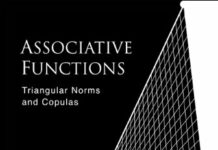
Ebook Info
- Published: 2011
- Number of pages: 346 pages
- Format: PDF
- File Size: 21.06 MB
- Authors: Claudi Alsina
Description
The authors present twenty icons of mathematics, that is, geometrical shapes such as the right triangle, the Venn diagram, and the yang and yin symbol and explore mathematical results associated with them. As with their previous books (Charming Proofs, When Less is More, Math Made Visual) proofs are visual whenever possible.The results require no more than high-school mathematics to appreciate and many of them will be new even to experienced readers. Besides theorems and proofs, the book contains many illustrations and it gives connections of the icons to the world outside of mathematics. There are also problems at the end of each chapter, with solutions provided in an appendix. The book could be used by students in courses in problem solving, mathematical reasoning, or mathematics for the liberal arts. It could also be read with pleasure by professional mathematicians, as it was by the members of the Dolciani editorial board, who unanimously recom
User’s Reviews
Editorial Reviews: Review Images, whether real or in the imagination, are a foundational component of mathematics. In this book the authors begin with 20 of the most fundamental real images and develop a series of consequences with proofs based on those images. A short section of challenge problems are given at the end of each chapter with solutions included in an appendix. Some of the 20 iconic images used are: Two circles, Venn diagrams, Polygons with circles, Right triangles, The semicircle, and The bride’s chair. A set of works in geometry, the book could be used as a text in a college course in Euclidean geometry; it is an excellent study item to prepare high school teachers of geometry. People currently teaching high school geometry will find it a valuable resource for more challenging problems to present to the students. Others with just an interest in geometry will find it worthy of an in-depth look. –Charles Ashbacher, Journal of Recreational MathematicsTreating mainly elementary geometry, this book can be enjoyed by amateurs and professionals alike. All that is needed is some secondary background in Euclidean geometry and trigonometry, seasoned with imagination. The twenty “icons,” or geometrical diagrams, some of historical interest, act as an organizing principle. Each sets the stage for a chain of related results, most established in an informal manner by standard Euclidean arguments, algebraic and trigonometric manipulations, and “proofs without words” using partitions and figure-shifting. Frequent digressions provide historical background, short biographies, notes about mathematical artefacts and information about how geometry intervenes in everyday life. Apart from standard results on circles and triangles, the authors discuss a variety of topics, including Dido’s isoperimetric problem, regular solids, reptiles, cevians, the butterfly theorem, Reuleaux polygons, polygonal numbers, triangulation of polygons, the cycloid, star polygons, self-similarity, and spirals and tilings. This book is particularly recommended for secondary mathematics students and th –E.J. Barbeau, Mathematical ReviewsCertain images in mathematics prompt an immediate reaction, similar to the way a smell can trigger a memory. In this provocative collection, the images chosen have what Alsina (Polytechnic Univ. of Catalonia, Spain) and Nelsen (Lewis and Clark College) believe to be iconic value, that is, they are universally recognized. The authors identify and name each image, and explain the image’s history, everyday appearance, and mathematical roles. Along with the classical results, they consider generalizations that are not well known but very engaging. For example, cevians make the list for their role in identifying the many special points of triangles. The authors also discuss Stewart’s theorem and a generalization to circles. Each of the volume’s 20 chapters ends with a “Challenges” section. This unusual work is a welcome addition to any library; all readers will find something to inform and even delight them. –J. McCleary, CHOICEIcons of Mathematics is #45 in the Dolciani Mathematics Expositions series, and it certainly lives up to the charge of the Dolciani series, providing highly readable discussions of a selection of 20 images that are as recognizable to the general public as they are to mathematicians. Each chapter focuses on one of the icons and includes a standard set of items: quotes from a wide variety of sources (Zhang Zai to Ralph Waldo Emerson), a short history of the figure including examples of uses of the image in mathematical and non-mathematical settings, examples of the figure in mathematical proofs of theorems or solutions to problems, and problems for the reader to solve. Outlines of the solutions to the problems are in the back of the book. The images range fro –Cheryl J. McAllister, MAA ReviewsThis is the third book by Claudi Alsina and Roger B. Nelsen in the MAA Dolciani Mathematical Expositions series. Each of the 20 chapters guiding to an extensive voyage to different fields of mathematics are represented by an icon. Some of these icons visualize classic theorems from elementary geometry such as Pythagoras’ Theorem, some are original visualizations of the authors. Starting off from the elementary geometrical aspects of the icon the voyage leads to often surprising mathematical relations with different fields of mathematics from planeand solid geometry, elementary number theory, equations and inequalities, calculus and recreational mathematics. Chapters always start with simple, well-known results leading to deeper, often unfortunately forgotten and sometimes unknown results with surprising relations. As an example, Chapter 4, represented by the icon of a semicircle, is described. After a short reminder of the role of simicircles in architecture, the voyage goes on to Thales’ triangle theorem and then to the geometric and arithmetic means. The next paragraphs discuss Dido’s theorem and the semicircles of Archimedes. Also, the harmonic mean is related to semicircles. More complex figures of semicircles lead to further trigonometric identities. Topics of the last two paragraphs on semicircles are area and perimeter of regular polygons and beautiful constructions of the five Platonic solids by Euclid. The chapter (as all others) ends with a number of further challenges with solutions provided in an appendix. Throughout the chapters there are marked text boxes, some with historical remarks (for example, a 17th century Reduction Compass( Fig. 5.10) and a Pantograph (Fig. 5.12) dating from 1631) or with other information (for example on a stamp series ‘The Ten Mathematical Formulas That Changed the Face of the Earth’ (Fig. 2.4)). The book makes interesting reading for mathematics teachers, it can also be used by students in courses in problem solving, mathematical reasoning, or mathematics for the liberal arts. It can also be read with pleasure by professional mathematicians with an interest in elementary geometry. –Hans-Wolfgang Henn, Zentrallblatt Book Description An exploration of the mathematics of twenty geometric diagrams that play a crucial role in visualizing mathematical proofs. Book Description An exploration of the mathematics of twenty geometric diagrams that play a crucial role in visualizing mathematical proofs. Those teaching undergraduate mathematics will find material here for problem solving sessions, as well as enrichment material for courses on proofs and mathematical reasoning. About the Author Claudi Alsina received his B.A. and Ph.D. in mathematics from the University of Barcelona. He has developed a wide range of international activities, research papers, publications and hundreds of lectures on mathematics and mathematics education. Roger B. Nelsen received his B.A. in mathematics from DePauw University and his Ph.D. in mathematics from Duke University. He was elected to Phi Beta Kappa and Sigma Xi, and taught mathematics and statistics at Lewis & Clark College for forty years before his retirement in 2009. Read more
Reviews from Amazon users which were colected at the time this book was published on the website:
⭐I collect math books, I’m an encyclopedist, and I’ve strived to learn all of math’s elegant details. If it’s a math fact that a reasonably intelligent person can understand in a minute, I want to know about it. I think it’s quite possible to learn all of the nice “low-hanging fruit” of mathematics. There are plenty of difficult areas of math that I’ll likely never get to, but I think I’ve learned all the simple stuff.Icons is a great diagram and fact heavy book. All told, there are about 800 interesting little morsels of math in here, all very approachable by anyone. At least 80 of these morsels were new to me, or I’d forgotten them, so this book ranks way up there for presentation and general usefulness to me.Highly receommended for recrational mathematicians.
⭐not enticing
⭐
⭐
⭐
Keywords
Free Download Icons of Mathematics: An Exploration of Twenty Key Images (Dolciani Mathematical Expositions) in PDF format
Icons of Mathematics: An Exploration of Twenty Key Images (Dolciani Mathematical Expositions) PDF Free Download
Download Icons of Mathematics: An Exploration of Twenty Key Images (Dolciani Mathematical Expositions) 2011 PDF Free
Icons of Mathematics: An Exploration of Twenty Key Images (Dolciani Mathematical Expositions) 2011 PDF Free Download
Download Icons of Mathematics: An Exploration of Twenty Key Images (Dolciani Mathematical Expositions) PDF
Free Download Ebook Icons of Mathematics: An Exploration of Twenty Key Images (Dolciani Mathematical Expositions)

